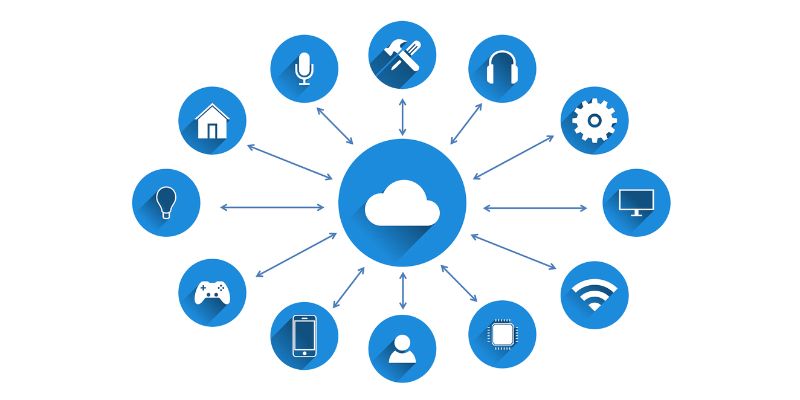Mitigating Security Risks in IoT: Is Blockchain the Ultimate Safeguard?
As our world grows smarter, so do its threats. Everyday, your tech connects, forming an “Internet of Things” (IoT), but with smarts come risks. How do we stay safe? Cue the blockchain. We must ace mitigating security risks in IoT with blockchain, stirring a tech revolution. Imagine a fortress, digital and strong, shielding connected gadgets. It’s not a pipe dream. Blockchain could be our digital knight, fighting to lock up our IoT world tight. Here’s the key: the chain’s not just for Bitcoin anymore. It’s IoT’s new guard, tough and sure. Eager for less hack worry, more smart tech glory? Let’s blast off to where blockchain meets IoT.
Understanding the Landscape of IoT Security Challenges
The Current State of IoT Vulnerabilities
Imagine your smart home gets hacked. Your private space is now open to strangers. This happens when smart devices lack good security. Many such gadgets connect to the internet today. We call this the Internet of Things, or IoT. But with more devices online, more bad guys try to sneak in. They hunt for weak spots. And trust me, they find them often.
IoT security challenges are real. Hackers can steal data or take control of devices. Your personal info could get into the wrong hands. Or maybe your smart fridge orders milk non-stop. Sounds silly, but it can happen. That’s why securing IoT devices is big talk. No one wants a fridge gone wild!
Overcoming the Limitations of Traditional IoT Security Models
Now you might think, can’t we use the old ways to protect these devices? Some try, but here’s the catch. IoT is huge. It grows every day. Old-school security can’t keep up. We need something tougher, smarter, and with muscle.
This is where blockchain for IoT security shines. You might have heard of blockchain with money stuff, like Bitcoin. It’s that, but for securing IoT devices. It’s like a steel door for data.
Blockchain makes records that no one can change. It uses tricky math called hash functions to lock data tight. It can check who’s sending info and stop fakes from slipping through. This is all about blockchain authentication. With smart contracts, it gets even better. They’re like robot guards who always follow the rules.
Using blockchain solutions for IoT helps us out big time. Devices talk to each other safer, and data stays pure. Think of it as making a castle out of your home network. IoT and blockchain integration is like giving your castle the best guards around.
You see, securing IoT with blockchain isn’t just smart. It’s strong. It’s turning your home into a fortress where data is the treasure. And as an expert who digs through these puzzles daily, I’m here to say, this fortress is starting to look pretty solid.

Unpacking the Integration of Blockchain into IoT
How Blockchain Technology Reinforces IoT Security
Now, let’s dive into how blockchain makes IoT safer. Imagine blockchain as a strong safe. It locks away IoT device data so only the right people can see it. These devices are things like fitness trackers or smart fridges. They collect loads of info. But if this private info gets stolen, that’s bad news. Blockchain steps in to stop this. It creates unbreakable codes. These codes shield our data from hackers.
Blockchain is like a team that agrees on what’s true. It works together to check data. No one member can trick the system. It secures data across many places. This means no single point is easy to attack.
Blockchain also offers a kind of digital handshake – ensuring only trusted devices talk to each other. This handshake makes sure messages between devices are real. Blockchain won’t let fake messages through. This keeps our smart homes and wrist watches safe.
Another cool point is blockchain keeps a clear record. No one can sneak in and change it. Infos stay honest and untouched. It brings trust without needing one boss to watch over it.
Real-World Applications of Blockchain in IoT Ecosystems
Let’s explore how real things we use every day can benefit from blockchain. Smart homes can be safer with blockchain. Locks, alarms, and lights can work together smoothly. With blockchain, neighbors or strangers can’t mess with them. Protection gets stronger.
In factories, machines with sensors need to share info securely. Blockchain helps here too. It guards the data, making sure instructions are correct. Machines do their jobs well. They don’t get confused with wrong or unsafe commands.
In healthcare, keeping patient info private is super important. Blockchain says ‘no’ to unwanted peeks into private health details. It lets doctors share patient data safely. This helps patients get the right treatment faster.
Blockchain helps farmers track food from farms to our tables. We can trust the food we eat is what it says it is. No more worries about unsafe or fake food.
For shipping, blockchain keeps a close eye on products moving around the world. It makes sure what’s inside the box matches the label. It stops sneaky changes during the journey.
In these ways, blockchain is like a superhero for IoT. It fights off the bad guys, keeping our info safe. It offers a secure way to connect smart devices. It makes sure they work together without any nasty surprises. Plus, it keeps everything honest and clear. Thanks to blockchain, the growing IoT world stands strong against cyber threats. We can enjoy our smart gadgets with less worry. It’s not just about safety; it’s about peace of mind. Blockchain gives us that – a strong guard for our smart world.

Implementing Blockchain for Enhanced Security and Data Integrity
The Role of Encryption and Authentication in IoT Devices
Securing IoT devices is tough. Hackers are smart and always finding holes. We need strong walls to keep them out. Blockchain technology gives us those walls. It locks data tight with complex math. This is called encryption. Imagine a secret code that only you and your friend know. That’s how blockchain keeps IoT safe. Each device gets a unique key. This key is like a magic password. It proves who’s talking to who.
Blockchain encryption methods are tough to crack. They use special math called hash functions. These turn data into jumbled codes. No one can read this without the right key. It’s super secure. Even if hackers get the data, it’s useless. It’s all gibberish to them. This makes your smart home safer. No one can peek at your devices without permission.
Blockchain authentication is a big deal too. It checks who’s sending and who’s receiving data. It’s like a secret handshake between devices. Each one knows the other is supposed to be there.
Leveraging Smart Contracts to Automate IoT Security
Smart contracts are game changers. They’re like robot lawyers living in the blockchain. They follow rules set by people. They make deals happen automatically. When conditions are met, they act. No human needs to check things. It’s all automatic and quick.
Say you’re using a smart home device. It sends data around. You want this to stay safe. Smart contracts help with this. They can decide if data can go through or not. It’s like a bouncer at a club. They check everything’s okay before letting data in. This happens fast, without any person needing to say it’s okay.
These contracts can also fix problems by themselves. They can tell if something’s wrong. Then they make decisions to protect your data. It’s like having a guard dog that’s smart. It knows when to bark and when everything’s cool.
With blockchain, smart devices talk to each other safer. No one can chip in. It’s just the devices chatting, following rules set in stone.
Blockchain for IoT security is no small thing. It’s changing how we keep our smart stuff safe. Data integrity in IoT is getting stronger. We can trust our devices more. They’re getting smarter at keeping themselves safe. It’s like giving them their own shield. Blockchain is a hero in this fight. It’s stopping bad guys and keeping our smart world secure.
IoT and blockchain integration is a big leap forward. We need to keep pushing for better ways to keep our devices safe. This mix is a strong step in that path. It’s cool to think about – our smart gadgets protecting themselves!

Navigating the Future of IoT with Blockchain Solutions
Addressing Scalability Challenges for Expanding IoT Networks
The key to growing IoT networks lies in scalability. Simply put, as more devices connect, the system must handle them without fail. This is tough but blockchain helps big time. Imagine it like a magic net that gets bigger as more fish swim in. It doesn’t break; it just stretches.
Blockchain’s decentralization plays a huge role here. Why? Because it spreads data across many computers. So as more devices join, more computers help carry the load. This keeps everything running smooth. Plus, with better tech, like hash functions and smart contracts, networks become even more scalable.
But here’s a real noodle bender: Can blockchain manage it all without crashing? Yes, thanks to things like sharding, which is like giving each computer a smaller piece of the pie to work with, and sidechains, which are like extra lanes on a highway for data. Also, there are different blockchains, like permissioned ones that only let certain devices in, that help manage the load.
So, by weaving blockchain into IoT, we help networks grow tall and strong. Like a sturdy tree that can hold many branches.
Balancing Regulatory Compliance with Innovation in IoT Security
Now, let’s talk about playing by the rules while keeping up with cool new tech. It’s a tough juggle. We need to protect people’s privacy and follow laws, but also not choke out innovation.
Blockchain’s a star player here because it’s transparent but also keeps secrets well. This sounds wild, but here’s the deal. Everyone can see the data blocks, but they can’t see what’s inside without the key. This is how blockchain keeps data safe but also plays by the rules.
You might think, “But wait, won’t regulators get fussy about all this?” Sure, they want to make sure everything’s on the up and up. But that’s where blockchain’s record-keeping skills shine. It creates a trail that can’t get messed with, which makes regulators happy because they can trust the data.
And with blockchain, creating policies for IoT security gets easier. As for keeping IoT identities secure, blockchain does that by ensuring no one fakes being something they’re not. Think of it as the ultimate ID checker.
So, with all its tools, like encryption and checking who’s who, blockchain helps IoT stay ahead, safe, and within the rules. And as we all know, happy regulators make for smooth sailing.
The future of IoT is like a fast car, and blockchain’s the super fuel making it zoom forward, securely and confidently. As we work on these amazing solutions, we can trust that our smarter world will also be a safer one.
In this post, we dove into IoT security and how blockchain can make a big difference. We looked at current IoT risks and how old security ways don’t always work. Then, we saw how blockchain helps keep IoT safe and checked out real cases where this is happening.
We also talked about using blockchain to keep data safe and true, and how encryption and smart contracts are key. Lastly, we touched on growing IoT networks and the need to balance rules and new ideas.
I believe blockchain is a game-changer for IoT. It makes things safer and can handle big changes and new rules. Keep an eye on this space; it’s always changing and can surprise us with even better ways to protect our connected world. Let’s stay smart and keep pushing for safer, smarter IoT solutions.
Q&A :
How Can Blockchain Technology Be Used to Secure IoT Devices?
Blockchain technology can enhance the security of IoT devices by providing a decentralized and immutable ledger for recording and verifying transactions and data exchanges. This feature helps to prevent unauthorized access and tampering by distributing the device data across a network of computers, making it much more difficult for hackers to manipulate.
What Are the Benefits of Integrating Blockchain with IoT Security?
Integrating blockchain with IoT security can offer multiple benefits:
- Improved Data Integrity: Blockchain’s immutable ledger means once data is recorded, it cannot be altered without detection.
- Enhanced Transparency: All network participants can view transaction histories, increasing trust in data exchanges.
- Reduced Costs: Blockchain can automate processes, reducing the need for intermediaries and lowering transaction costs.
- Increased Efficiency and Speed: Blockchain can process transactions more quickly compared to traditional methods.
- Decentralization: With no central point of control, it’s harder for cyberattacks to succeed since the data is spread across the blockchain.
What Challenges Exist When Combining Blockchain and IoT?
Combining blockchain with IoT presents several challenges:
- Scalability: Blockchain networks can struggle with large volumes of transactions which is typical for IoT applications.
- Complexity: Integration can be technically complex, requiring significant resources and expertise.
- Speed: Blockchain can be slower than traditional databases due to its consensus mechanisms.
- Energy Consumption: Blockchain operations, especially those using Proof of Work, can be energy-intensive.
Are There Any Real-world Applications of IoT and Blockchain Being Used Together?
Yes, there are several real-world applications:
- Smart Contracts in Supply Chain: Tracking goods through every stage to ensure integrity and timely delivery.
- Energy Distribution: Creating decentralized and transparent grids for energy management.
- Healthcare Data Management: Secure sharing of patient data between devices and healthcare professionals.
How Does Blockchain Improve Privacy in IoT Systems?
Blockchain improves privacy in IoT systems by enabling pseudonymity; users can interact on the network without exposing personal details. Smart contracts enforce data sharing rules, and the encryption inherent in blockchain ensures data is shared securely and only with authorized parties. This reduces the risk of personal data breaches common in centralized IoT systems.



